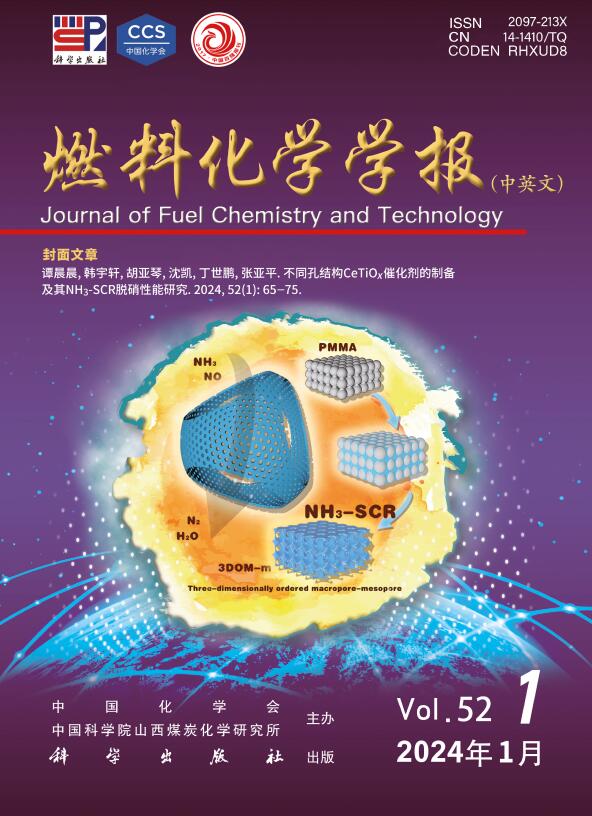Catalytic desorption performance of CO2-rich amine solution over SO2− 4/TiO2-HZSM-5
Q3 Energy
引用次数: 0
Abstract
Amine-based solution absorption method, as the most mature CO2 capture technology, requires enhancing CO2 desorption performance while reducing energy consumption in desorption. A series of SO2− 4/TiO2-HZSM-5 catalysts with different TiO2 contents were prepared by sol-gel method using HZSM-5 as carrier and used in CO2 catalytic desorption of N-methyl-diethanolamine and piperazine blended amine solution. Results indicated that catalyst performance can be regulated by changing the loading amount of TiO2. When the mass ratio of TiO2 to HZSM-5 was 2/1, the resultant STH(2/1) catalyst had large mesoporous surface area and abundant acidic sites and exhibited excellent catalytic performance. Compared with non-catalytic system, CO2 desorption amount of the entire desorption increased by 15.38% and relative heat duty decreased by 21.69%. Meanwhile, STH(2/1) exhibited good activity and stability after regeneration cycles and had no impact on CO2 absorption performance. Larger mesoporous surface area of catalyst facilitated sufficient contact between reactants and acidic sites. Abundant amount of strong acid sites and Brønsted acid sites provided a large amount of H+, promoting the decomposition of carbamate and deprotonation of protonated amines. The combined action of mesoporous surface area, strong acid sites and Brønsted acid sites promoted CO2 desorption. In addition, a possible mechanism for CO2 desorption catalyzed by SO2− 4/TiO2-HZSM-5 was proposed.
富co2胺溶液在SO2−4/TiO2-HZSM-5上的催化脱附性能
胺基溶液吸收法作为最成熟的CO2捕集技术,要求在提高CO2解吸性能的同时降低解吸过程中的能耗。以HZSM-5为载体,采用溶胶-凝胶法制备了一系列不同TiO2含量的SO2−4/TiO2-HZSM-5催化剂,用于n -甲基-二乙醇胺和哌嗪混合胺溶液的CO2催化解吸。结果表明,通过改变TiO2的负载量可以调节催化剂的性能。当TiO2与HZSM-5的质量比为2/1时,得到的STH(2/1)催化剂具有较大的介孔表面积和丰富的酸性位点,具有优异的催化性能。与非催化体系相比,整个脱附过程的CO2脱附量提高了15.38%,相对热负荷降低了21.69%。同时,STH(2/1)在再生循环后表现出良好的活性和稳定性,对CO2的吸收性能没有影响。催化剂的介孔表面积较大,有利于反应物与酸性位点之间的充分接触。大量的强酸位点和Brønsted酸位点提供了大量的H+,促进氨基甲酸酯的分解和质子化胺的去质子化。介孔表面积、强酸位和Brønsted酸位的共同作用促进了CO2的脱附。此外,提出了SO2−4/TiO2-HZSM-5催化CO2脱附的可能机理。
本文章由计算机程序翻译,如有差异,请以英文原文为准。
求助全文
约1分钟内获得全文
求助全文
来源期刊

燃料化学学报
Chemical Engineering-Chemical Engineering (all)
CiteScore
2.80
自引率
0.00%
发文量
5825
期刊介绍:
Journal of Fuel Chemistry and Technology (Ranliao Huaxue Xuebao) is a Chinese Academy of Sciences(CAS) journal started in 1956, sponsored by the Chinese Chemical Society and the Institute of Coal Chemistry, Chinese Academy of Sciences(CAS). The journal is published bimonthly by Science Press in China and widely distributed in about 20 countries. Journal of Fuel Chemistry and Technology publishes reports of both basic and applied research in the chemistry and chemical engineering of many energy sources, including that involved in the nature, processing and utilization of coal, petroleum, oil shale, natural gas, biomass and synfuels, as well as related subjects of increasing interest such as C1 chemistry, pollutions control and new catalytic materials. Types of publications include original research articles, short communications, research notes and reviews. Both domestic and international contributors are welcome. Manuscripts written in Chinese or English will be accepted. Additional English titles, abstracts and key words should be included in Chinese manuscripts. All manuscripts are subject to critical review by the editorial committee, which is composed of about 10 foreign and 50 Chinese experts in fuel science. Journal of Fuel Chemistry and Technology has been a source of primary research work in fuel chemistry as a Chinese core scientific periodical.
 求助内容:
求助内容: 应助结果提醒方式:
应助结果提醒方式:


